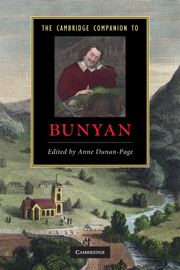Book contents
- Frontmatter
- Introduction
- Part I John Bunyan in his seventeenth-century context
- Part II John Bunyan’s major works
- 5 Grace Abounding to the Chief of Sinners: John Bunyan and spiritual autobiography
- 6 The Pilgrim’s Progress and the line of allegory
- 7 Bunyan and the early novel: The Life and Death of Mr Badman
- 8 Militant religion and politics in The Holy War
- 9 A Book for Boys and Girls: Or, Country Rhimes for Children: Bunyan and literature for children
- Part III Readership and reception
- Guide to further reading
- Index
8 - Militant religion and politics in The Holy War
from Part II - John Bunyan’s major works
Published online by Cambridge University Press: 28 July 2010
- Frontmatter
- Introduction
- Part I John Bunyan in his seventeenth-century context
- Part II John Bunyan’s major works
- 5 Grace Abounding to the Chief of Sinners: John Bunyan and spiritual autobiography
- 6 The Pilgrim’s Progress and the line of allegory
- 7 Bunyan and the early novel: The Life and Death of Mr Badman
- 8 Militant religion and politics in The Holy War
- 9 A Book for Boys and Girls: Or, Country Rhimes for Children: Bunyan and literature for children
- Part III Readership and reception
- Guide to further reading
- Index
Summary
In the introduction to their seminal edition of The Holy War (1682) Roger Sharrock and James Forrest identify a softening of Bunyan's attitude in the 1670s concerning 'the terrors that had haunted his conscience' (HW, p. xiv) regarding hell and damnation. They argue that the harsher and more rigidly defined theology of predestination, hitherto predominant in Bunyan's writing, was becoming gentler, being gradually replaced by an inclination towards the 'mercy and relief available to Christians'. An example is provided by the actions of Emanuel in The Holy War, a paragon of goodness and mercy, who constantly forgives the ingratitude of Mansoul's citizens for their disobedience, and lack of constancy and discipline (HW, pp. xiv, xvi). Yet The Holy War is a profoundly violent text where Emanuel's mercy and forgiveness are tempered by his willingness to wage war in a determined and bloody fashion. Violent conflict is everywhere apparent, as a line from the prefatory poem to the text makes clear: 'Mansoul, it was the very seat of war' (HW, p. 4). When the battle for the town of Mansoul takes place between the forces of good and evil, led by Emanuel and Diabolus respectively, the text informs us that 'many were maimed and wounded, and slain' (HW, p. 83). When Emanuel recaptures the town of Mansoul for the first time from the occupying forces of Diabolus, the chief among the ungodly are tried and crucified. In its depiction of armed conflict, and in its characterisation of the warrior for religious truth, Bunyan's narrative closely resembles Milton's in Paradise Lost (1667). Neil Keeble has observed that Bunyan, like Milton, was a 'transgressive and subversive author' whose dissent from the established church was lifelong and pronounced.
- Type
- Chapter
- Information
- The Cambridge Companion to Bunyan , pp. 107 - 119Publisher: Cambridge University PressPrint publication year: 2010

